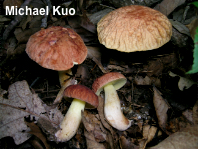| Major Groups > Boletes > Leccinum > Hemileccinum hortonii |

|
Hemileccinum hortonii [ Basidiomycota > Boletales > Boletaceae > Hemileccinum . . . ] by Michael Kuo This fascinating bolete is relatively common in eastern North America's oak forests. It has a tightly wrinkled cap surface that turns green with ammonia, a yellow pore surface, and a stem that appears bald and unadorned but on close inspection features tiny scabers. The flesh and pore surface occasionally bruise slightly bluish, especially in older specimens. Mycologists have long struggled with how to fit Hemileccinum hortonii into taxonomic arrangements. It was originally named Boletus subglabripes var. corrugis by Peck (1889), since it was so similar to Boletus subglabripes (now Hemileccinum subglabripes), appearing to differ only in its consistently wrinkled cap. Smith & Thiers (1971) elevated Peck's variety to species status, renaming it in his honor (Peck's middle name was Horton) in the process. Boletus hortonii is indeed very similar to Hemileccinum subglabripes, but its cap is consistently corrugated-wrinkled, the stem is proportionally a little stockier, the structure of its pileipellis is different, and the green reaction to ammonia is not found in Leccinum subglabripes or anywhere else among leccinoid fungi. DNA results (Kuo & Ortiz-Santana 2020) support placement of Boletus hortonii in Hemileccinum. Boletus subglabripes var. corrugis, Leccinum hortonii, and Xerocomus hortonii are synonyms. Description: Ecology: Mycorrhizal with oaks and possibly with other hardwoods; appearing alone or gregariously; summer and fall; widely distributed east of the Rocky Mountains. The illustrated and described collections are from Illinois. Cap: 3–10 cm; convex, becoming broadly convex; dry or a little greasy; bald; tightly corrugated-wrinkled (very rarely only slightly wrinkled); reddish brown to orangish brown; with or without a tiny (under 1 mm) sterile overhanging margin. Pore Surface: Bright yellow when young, becoming olive; not bruising, or bruising a little blue when mature; 2–3 pores per mm at maturity; tubes to 10 mm deep; by maturity often depressed at the stem. Stem: 4–8 cm long; 1–2 cm thick; fairly equal; with tiny scabers that are initially yellow but mature to reddish; overall appearing yellow at first, then slowly developing red colors from the base upwards; basal mycelium white. Flesh: Pale yellow or whitish; not staining on exposure—or sometimes bluing slightly. Odor and Taste: Not distinctive. Chemical Reactions: Ammonia flashing green on cap surface, then resolving to gray; negative on flesh. KOH blackish on cap surface; orangish on flesh. Iron salts negative on cap; negative on flesh. Spore Print: Olive brown. Microscopic Features: Spores 10–12.5 x 3–4 µm; fusiform; smooth; yellowish in KOH. Basidia clavate; 4-sterigmate. Hymenial cystidia not found. Pileipellis a trichoderm of inflated, chained elements (an epithelium); terminal elements either clavate to subglobose, 5–15 µm across—or cylindric-cystidioid, 25–40 x 2.5-5 µm, with rounded apices; both types smooth, hyaline in KOH, thin-walled. In cystidioid elements, subterminal cells sometimes swollen to various degrees. REFERENCES: (Peck, 1889) M. Kuo & Ortiz-Santana, 2020. (Coker & Beers, 1942; Smith & Thiers, 1971; Smith, Smith & Weber, 1981; Phillips, 1991/2005; Both, 1993; Bessette et al., 2000; Roody, 2003; McNeil, 2006; Kuo, 2007; Binion et al., 2008; Kuo & Methven, 2014; Bessette et al., 2016; Woehrel & Light, 2017; Sturgeon, 2018; Kuo & Ortiz-Santana, 2020.) Herb. Kuo 05300407, 07050706, 06180804. This site contains no information about the edibility or toxicity of mushrooms. |
|
|
Cite this page as: Kuo, M. (2020, January). Hemileccinum hortonii. Retrieved from the MushroomExpert.Com Web site: http://www.mushroomexpert.com/hemileccinum_hortonii.html © MushroomExpert.Com |








